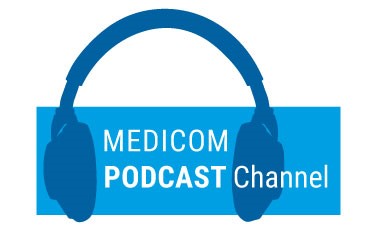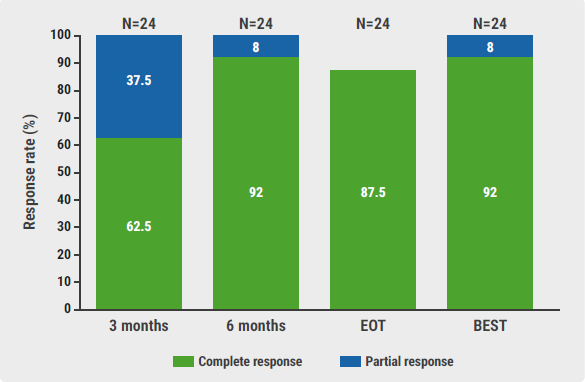
ZUMA-7 (NCT03391466) is the first randomised CAR T-cell trial in patients with relapsed/refractory large B-cell lymphoma (R/R LBCL) [1]. After a median follow-up of 24.9 months, the study met its primary event-free survival (EFS) endpoint, demonstrating a statistically significant and clinically meaningful improvement with axi-cel compared with second-line standard of care in this patient population.
The standard of care treatment in the curative setting for patients with R/R LBCL after first-line chemoimmunotherapy is high-dose therapy in combination with autologous stem cell rescue (HDT-ASCT) if responsive to second-line chemoimmunotherapy. However, because many patients do not respond to or cannot tolerate second-line chemoimmunotherapy, or are not eligible for high-dose therapy and ASCT, outcomes remain poor.
Axi-cel versus standard-of-care
Axi‑cel is an autologous anti‑CD19 chimeric antigen receptor (CAR) T-cell therapy approved for the treatment of patients with R/R LBCL after ≥2 prior systemic therapies. Since CAR T-cell therapy may benefit patients in earlier lines of therapy, Dr Frederick Locke (Moffitt Cancer Cancer, Tampa, Florida, USA) and others conducted ZUMA-7, a global, randomised, open-label, phase 3 trial of axi-cel compared with the standard of care in patients with second-line R/R LBCL. Dr Locke reported the results of the primary analysis.
The 359 patients enrolled had a median age was 59 years; 30% was ≥65 years. Overall, 74% of patients had primary refractory disease and 46% had high second-line age-adjusted International Prognostic Index score (sAAIPI, 2–3).
Superiority over standard-of-care
The primary endpoint of EFS, a composite of time to earliest date of disease progression, death from any cause, or new lymphoma therapy, was met (hazard ratio 0.398; 95% CI, 0.308-0.514, P<0.0001). After a median follow-up of 24.9 months, median EFS was significantly longer with axi-cel versus standard of care, namely 8.3 months (95% CI: 4.5–15.8) versus 2 months (95% CI: 1.6–2.8), respectively. Importantly, Kaplan-Meier estimates of the 24-months EFS rates were significantly higher with axi-cel (40.5% vs 16.3%). “This means that patients who receive either axi-cel or the standard of care are going on for 2 years after randomisation, without a need for any further therapy and remain in remission,” Dr Locke added.
Axi-cel showed superiority over standard-of-care with a more than 4-fold greater median EFS, a 2.5-fold greater EFS at 2 years, a doubling of the CR rate, and EFS improvements across key subgroups. Nearly 3 times the number of patients in the axi-cel arm received definitive treatment versus the standard of care arm. The safety profile of axi-cel was manageable and at least consistent with third-line treatment with axi-cel in patients with R/R LBCL [2,3].
Potential paradigm shift
ZUMA-7 is the first randomised, global, multicentre phase 3 study of axi-cel compared with second-line standard of care in R/R LBCL, demonstrated a statistically significant and clinically meaningful improvement in EFS.
Dr Locke thinks that axi-cel means a paradigm shift as the standard of care for second-line treatment of patients with R/R LBCL. Axi-cel may replace chemoimmunotherapy and high-dose therapy in combination with ASCT in this patient population.
- Locke F, et al. Primary Analysis of ZUMA 7: A Phase 3 Randomized Trial of Axicabtagene Ciloleucel (Axi-Cel) Versus Standard of Care Therapy in Patients with Relapsed/Refractory Large B-Cell Lymphoma. Asbtarct 2, ASH 2021 Annual Meeting, 11-14 Dec.
- Neelapu SS, et al. N Engl J Med. 2017;377:2531-2544.
- Locke FL, et al. Blood 2017:130 (suppl_1);2826.
Copyright ©2022 Medicom Medical Publishers
Posted on
Previous Article
« Comparable outcomes with second-line tisa-cel versus standard-of-care for relapsed/refractory aggressive NHL Next Article
Axi-cel more effective but tisa-cel less toxic in large B-cell lymphoma »
« Comparable outcomes with second-line tisa-cel versus standard-of-care for relapsed/refractory aggressive NHL Next Article
Axi-cel more effective but tisa-cel less toxic in large B-cell lymphoma »
Table of Contents: ASH 2021 Focus on CAR T-Cell Therapy
Featured articles
Axi-cel improved event-free survival in relapsed/refractory large B-cell lymphoma
CAR T-cell Therapy
Most re-hospitalisations within first month from CAR T-cell infusion
CD22-directed CAR T-cell therapy safe and well-tolerated in R/R LBCL
High rate of rapid and complete responses with axi-cel in high-risk large B-cell lymphoma
Novel anti-CD19 plus lenalidomide prolonged survival in R/R DLBCL
Liso-cel superior to standard-of-care as second-line therapy in large B-cell lymphoma
CIRS is predictive of outcomes in CAR T-cell recipients with R/R DLBCL
Axi-cel more effective but tisa-cel less toxic in large B-cell lymphoma
Axi-cel improved event-free survival in relapsed/refractory large B-cell lymphoma
Comparable outcomes with second-line tisa-cel versus standard-of-care for relapsed/refractory aggressive NHL
Improved QoL with axi-cel versus standard-of-care in R/R LBCL
Related Articles

January 4, 2022
ASH 2021 Highlights Podcast
September 1, 2020
Higher risk of severe COVID-19 seen in people with blood cancers

© 2024 Medicom Medical Publishers. All rights reserved. Terms and Conditions | Privacy Policy
HEAD OFFICE
Laarderhoogtweg 25
1101 EB Amsterdam
The Netherlands
T: +31 85 4012 560
E: publishers@medicom-publishers.com

